Growing up on the farm, we’d often eat our mid-day meal (what we referred to as dinner, but most of the world now calls lunch) at my grandparents’ house, which was the farm’s home base. It was a planned break from planting, harvesting, chore work, mowing, baling hay or one of dozens of other never-ending tasks. Grandma would go all-in, both with a homemade meal followed by a mouth-watering dessert. She only had but two rules: wash your hands before you sit down at the table and pray before touching your food. This was a time when we shared stories from the morning, discussed our plans and challenges for the afternoon and took advice from Grandpa (whether we sought it or not). But at 12-noon, all voices ceased. That’s when Grandpa turned up the radio, and we listened to the daily markets (often amongst his grunts and groans) and local weather forecasts. He then turned the volume down slightly and we would resume conversation against the backdrop of other farm-related news on WGIL radio in Galesburg, Illinois. Hometown radio is still viable in many areas of the country, especially in the Midwest. This is where locals tune-in to receive local news, commentary and even listen to live coverage of local high school football and basketball teams. Since they are largely in rural communities, many of these stations have dedicated farm programming, either from their own farm broadcaster and/or most often these days as an affiliate for a state-wide or regional ag network. Farm radio remains the top daily source of farm news – nearly 2x more than any other form of media – by about two-thirds of farmers. One-third of all 500+ acre growers are listening to local radio at any given time during the day. Last week, I appeared on RFD-Radio, discussing the foliar feeding of Huma’s Super Nitro to corn. You can listen to that interview here at the 45:00 mark (as well as my recent interview on the Iowa Agribusiness Network here at 16:27). One of RFD’s 77 affiliates across the Prairie State is WGIL. While conversing with the broadcaster, I felt transported back to those memorable days in my grandparents’ kitchen, when my only concerns were if there was rain in forecast and what flavor of pie was for dessert. Grandpa, I hope you were listening.
Between the markets, soaring input and machinery costs, excessive rains and hail across much of our nation’s breadbasket, it is little wonder why farmer attitudes are waning. Purdue’s Farm Capital Investment Index – which monitors if now is a good time to invest in their operation – is approaching a historic low, falling to 30 points below the mean score. High interest rates, high input costs and low commodity prices continue to plague the American farmer. Hope will not come in the form of a Farm Bill anytime soon. Recently, USDA Secretary Vilsack was anything but receptive of the House plan, calling it political, not practical, and funded by gimmicks, calling for them to go back to the drawing board. This should come as no surprise given the country’s political landscape in an election year.
Silks on much of my corn have darkened, so pollination has come to an end. It’s been a stressful reproduction period, to say the least. From the moment tassels popped, we’ve experienced daily highs in the mid 90s and only two days of rain, totaling about 1 inch. Last Monday, I irrigated for the second week in a row. That said, I’ve observed significant ear size throughout the field: many ears are over 40 kernels long. This is especially impressive given my very high plant population of 48,000. Milder temperatures in the high 80s will be a welcome relief this week.
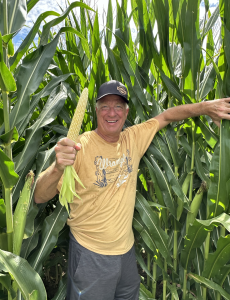
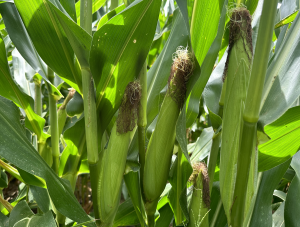
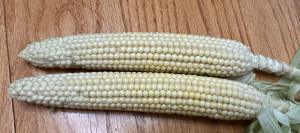
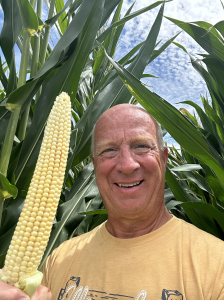
I was worried the extreme heat and humidity we encountered over the past two weeks would compromise pollination. Based on the photos above, it didn’t. These are two random ears, not the biggest I saw during scouting, but indicative of the field population. The bottom ear is 16 kernels round and 42 long; the top is 18 rounds and 40 long. The topsoil still contains moisture, and that hurricane figures to blow in rain this week. If not, we’ll turn on the water. I’d like to make one more product application. Due to the plant height, ground application is not an option, so I’m looking into using a drone. At this point, it’s all about increasing kernel size and adding weight.
Related Posts

This Week in Ag #20
Wheat harvest is well underway throughout the country. Each morning, the harvest process begins with equipment maintenance. Most farmers and custom cutters will park their fleet in a row, or in close proximity, so they can readily perform daily service. This involves the grease gun. Combines have hundreds of moving parts. Some of the most key

This Week in Ag #46
A new year brings new hope and new predictions. Gazing into my crystal ball, here’s what’s taking shape in 2024: “Just in time” fertilizer application will continue. Granted, I still saw lots of knife-marked farm fields across Illinois while I was home for the holidays. But the practice of applying nutrients exactly when they are
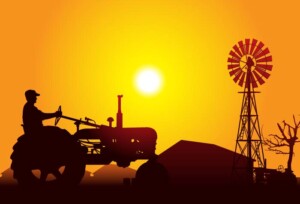
This Week in Ag #2
Are we looking at a fertilizer shortage? Guess it depends on your definition. The availability of fertilizer isn’t a major concern in the US. It really wasn’t last year, either. As a good friend (who I consider to be among the best farmers in the country) told me last winter, “you can get it, it’s

